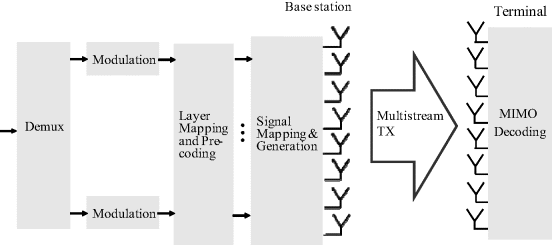6.4 Physical Layer Impact from Downlink MIMO
The enhancing of the downlink multi-antenna capabilities mainly impacts the physical layer in the 3GPP specifications. The addition of the eight parallel streams increases the momentary peak data rate and requires these eight parallel data streams to be transmitted and received using eight antennas. Obviously, the eight stream transmission is not expected to be used in the very near future, simply due to the added complexity of supporting eight transmitter antennas in the eNodeB and eight receiver antennas in the UE side. The amount of actual code words to be transmitted has not been increased from two code words, even if up to eight layers are being used; this allows one to minimize the feedback needed. The possibility of going up to an eight -layer transmission is shown in Figure 6.3; new reference signal solutions and improved feedback form the new Transmission Mode 9 (TM9) on top of the eight modes defined in Release 8 and 9 as listed in Chapter 3.
Figure 6.3 MIMO transmitter structure with eight transmitter and receiver antennas.

The Channel State Information Reference Signals (CSI-RS) enable the use of terminal feedback to cover for the operation with up to eight antennas without having to send the Common Reference Signals (CRS) all the time for that purpose from four or eight antennas. The CSI-RS is intended for the feedback generation, ...
Get LTE Advanced: 3GPP Solution for IMT-Advanced now with the O’Reilly learning platform.
O’Reilly members experience books, live events, courses curated by job role, and more from O’Reilly and nearly 200 top publishers.

